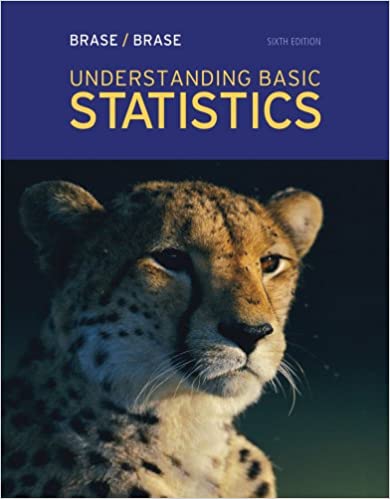
Understanding Basic Statistics 6th Edition by Charles Henry Brase,Corrinne Pellillo Brase
Edition 6ISBN: 978-1111827021
Understanding Basic Statistics 6th Edition by Charles Henry Brase,Corrinne Pellillo Brase
Edition 6ISBN: 978-1111827021 Exercise 71
Please provide the following information for Problems 11-22, part (a):
(i) What is the level of significance State the null and alternate hypotheses.
(ii) Check Requirements What sampling distribution will you use What assumptions are you making What is the value of the sample test statistic
(iii) Find (or estimate) the P -value. Sketch the sampling distribution and show the area corresponding to the P -value.
(iv) Based on your answers in parts (i) - (iii), will you reject or fail to reject the null hypothesis Are the data statistically significant at level a
(v) Interpret your conclusion in the context of the application.
Note: For degrees of freedom d.f. not in the Student's t table, use the closest d.f. that is smaller. In some situations, this choice of d.f. may increase the P -value a small amount, and therefore produce a slightly more "conservative" answer.
Answers may vary due to rounding.
Crime Rate: FBI A random sample of n 1 = 10 regions in New England gave the following violent crime rates (per million population):
x 1 : New England crime rate

Another random sample of n 2 = 12 regions in the Rocky Mountain states gave the following violent crime rates (per million population):
x 2 : Rocky Mountain states crime rate

(Reference: Crime in the United States , Federal Bureau of Investigation.) Assume that the crime rate distribution is approximately normal in both regions. Use a calculator to verify that
 , S 1 0.81,
, S 1 0.81,
 , and S 2 0.94.
, and S 2 0.94.
(a) Do the data indicate that the violent crime rate in the Rocky Mountain region is higher than that in New England Use = 0.10.
(b) Find a 98% confidence interval for 1 2. Explain the meaning of the confidence interval in the context of the problem.
(i) What is the level of significance State the null and alternate hypotheses.
(ii) Check Requirements What sampling distribution will you use What assumptions are you making What is the value of the sample test statistic
(iii) Find (or estimate) the P -value. Sketch the sampling distribution and show the area corresponding to the P -value.
(iv) Based on your answers in parts (i) - (iii), will you reject or fail to reject the null hypothesis Are the data statistically significant at level a
(v) Interpret your conclusion in the context of the application.
Note: For degrees of freedom d.f. not in the Student's t table, use the closest d.f. that is smaller. In some situations, this choice of d.f. may increase the P -value a small amount, and therefore produce a slightly more "conservative" answer.
Answers may vary due to rounding.
Crime Rate: FBI A random sample of n 1 = 10 regions in New England gave the following violent crime rates (per million population):
x 1 : New England crime rate

Another random sample of n 2 = 12 regions in the Rocky Mountain states gave the following violent crime rates (per million population):
x 2 : Rocky Mountain states crime rate

(Reference: Crime in the United States , Federal Bureau of Investigation.) Assume that the crime rate distribution is approximately normal in both regions. Use a calculator to verify that
 , S 1 0.81,
, S 1 0.81,  , and S 2 0.94.
, and S 2 0.94.(a) Do the data indicate that the violent crime rate in the Rocky Mountain region is higher than that in New England Use = 0.10.
(b) Find a 98% confidence interval for 1 2. Explain the meaning of the confidence interval in the context of the problem.
Explanation
We are using the calculator, the verifie...
Understanding Basic Statistics 6th Edition by Charles Henry Brase,Corrinne Pellillo Brase
Why don’t you like this exercise?
Other Minimum 8 character and maximum 255 character
Character 255


